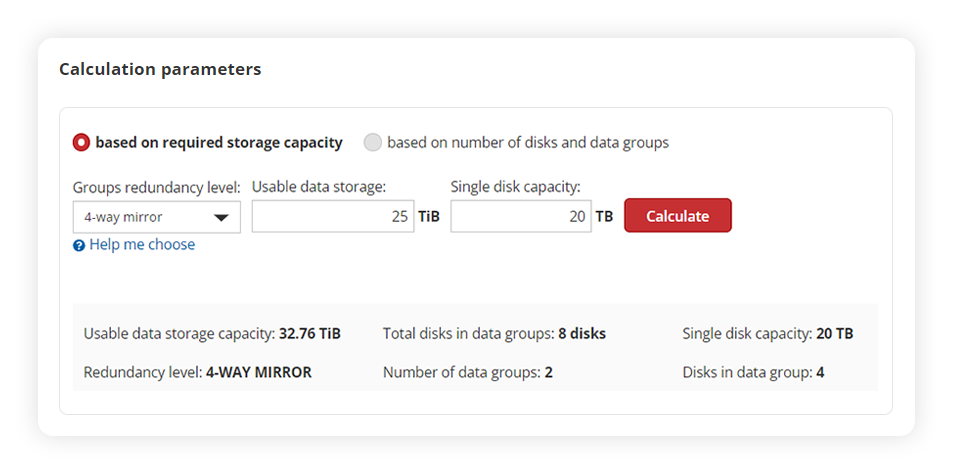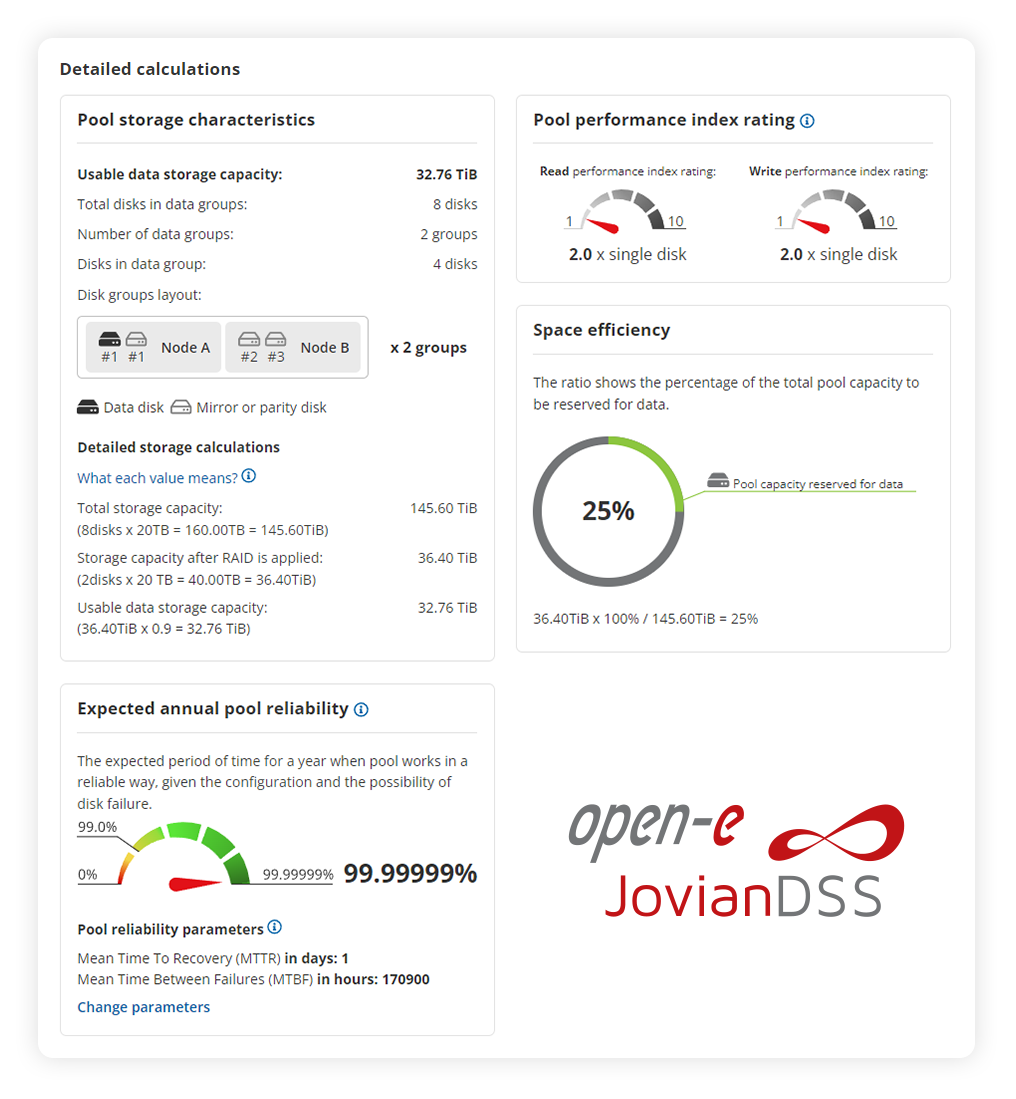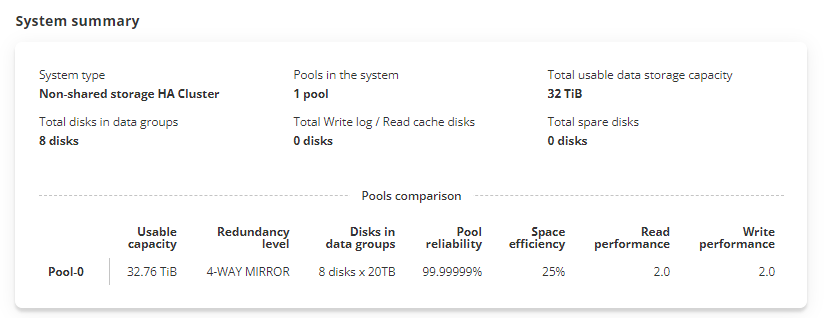Recently, one of our partners faced a challenge while designing a high-availability cluster with non-shared storage. The setup consisted of two nodes stretched between two separate locations, each with independent data storage. The customer’s priority was to create a high-availability data storage cluster tailored to end-user needs, without exceeding budget limits. While RAID-Z redundancy has been considered, it proved inefficient and complex for this purpose. Therefore, we recommended mirroring configurations, which are far better suited to HA cluster setups.
The main question they raised was:
“Why are there only mirroring redundancy levels offered in the Open-E high-availability data storage cluster, even if it comes at the cost of space efficiency?”
The Expense of Space in a High Availability Cluster
The reasoning behind this lies in how RAID distributes data and checksums across all available drives. If RAID were implemented across both non-shared data storage nodes, any node failure could render the data inaccessible or lost. This contradicts the very concept of a high-availability cluster, where continuous data access and uptime are crucial.
In the Open-E High-availability Data Storage Cluster, like any other, redundancy methods must prioritize fault tolerance between nodes, not just within one. While RAID works well locally, it’s not optimal for a stretched HA data storage cluster, because losing a node can compromise the entire data pool.
Data Storage Simplicity Equals Reliability
Searching for RAID-based workarounds only complicates the infrastructure without guaranteeing safety. A high-availability data storage cluster built with mirroring methods may sacrifice space efficiency, but it boosts performance, reliability, and most importantly, data safety. For mission-critical environments, these are essential trade-offs.
Decision-Making Skills in HA Clusters Implementation
Back to the real-world example based on Open-E JovianDSS: once we convinced the customer to use mirrored redundancy, the next decision was whether to use 2-way or 4-way mirroring. Since the primary goal was to reduce costs without compromising the core values of a high-availability data storage cluster – performance, scalability, and data protection – we had to weigh the pros and cons of each approach.
“Is it necessary to invest more in a 4-way mirror, or is 2-way mirroring sufficient for safe and efficient storage in an HA cluster?”
This decision influences the overall architecture and long-term maintenance costs of a high-availability data storage cluster.
The Best Way for a High Availability Cluster
Generally, 2-way mirroring offers better space efficiency than 4-way mirroring but provides less resilience to drive failures. Historically, 4-way mirroring was favored due to the limitations of HDD technology. Today, with the affordability and increased reliability of SSDs and NVMe drives, 2-way mirroring has become a viable and efficient option, even for a high-availability data storage cluster.
An all-flash architecture built with SAS SSDs or NVMe SSDs is becoming an increasingly affordable and reliable solution for HA data storage cluster infrastructures. This gives data storage administrators options that were not feasible during the HDD-only era. When designing your cluster, it is crucial to understand the trade-offs between SAS SSDs and NVMe SSDs:
- HDDs are still widely used for bulk storage because of their low cost per GB, reliability for sequential workloads, and ease of replacement and compatibility. However, it comes at the expense of data access speeds, higher latency, and limited IOPS compared to flash-based alternatives. Hence, their rebuild times in mirrored configurations are significantly longer, which increases the window of vulnerability in the event of a drive failure. They work best in 4-way mirroring, which provides triple redundancy, meaning up to 3 drives can fail in a mirror group before data is lost – very useful when rebuilds are slow.
- SAS SSDs deliver excellent reliability, endurance, and broad compatibility. They provide high performance with predictable and stable throughput, making them a trustworthy choice for HA data storage cluster deployments. Their relatively low cost per gigabyte suits storage environments where consistent speed and cost-efficiency are priorities.
- NVMe SSDs offer superior performance, especially for latency-sensitive or I/O-intensive applications. Their direct connection to the CPU via the PCIe bus eliminates bottlenecks typical of SAS interfaces, resulting in increased bandwidth and lower latency. This can significantly enhance the responsiveness of mirrored HA clusters. However, NVMe drives come at a higher cost per gigabyte and require updated infrastructure, such as newer motherboards and host bus adapters that support NVMe.
Therefore, if your high-availability data storage cluster prioritizes maximum throughput and minimal latency, and you are prepared for the associated investment, NVMe SSDs are the ideal choice. If long-term cost-efficiency, reliability, and stable speed are more important, SAS SSDs may be more appropriate, especially when combined with 2-way mirroring, where cost balancing is critical.
A key distinction remains: a 2-way mirror provides 50% usable capacity, while a 4-way mirror reduces this to 25%, offering enhanced fault tolerance. The right choice depends on your required balance between data storage efficiency and system reliability, the core pillars of any high-availability data storage cluster design.
Design and Calculate Your High Availability Cluster
There’s no better tool to visualize and compare these configurations than the Open-E JovianDSS Storage and RAID Calculator. This tool allows users to input their setup requirements and receive a detailed analysis of how a 2-way or 4-way mirror would function within a high-availability data storage cluster.
The calculator shows:
- Usable and single-disk storage capacity
- Redundancy level
- Number of disk groups and drives per group
- Pool performance rating
- Annual pool reliability
- Space efficiency

The final flourish is the system summary provided in a nutshell. It provides you with all those mentioned above in a comprehensive but compressed form, making it simple to compare the results (pool comparison) and draw conclusions. These values allow for comparing which mirroring ‘way’ gives the best and worst score in each category. Once users determine which factor is most important, they can plan how to invest money wisely and decide if they can save resources on others.

All this allows IT professionals to compare storage architectures and optimize their high-availability cluster design according to their business needs.

Optimization: The Final Step in Building a HA Cluster
When choosing between redundancy levels in a high-availability cluster, administrators should consider what their organization values most. Is it storage efficiency? Or does your infrastructure demand maximum reliability and fault tolerance?
Understanding these priorities will guide your decision between 2-way and 4-way mirroring – both viable in a modern HA data storage cluster, depending on hardware and business goals.
Managing a high-availability data storage cluster requires more than technical know-how. It involves strategic planning and financial acumen. IT administrators must communicate storage investment needs clearly to leadership, ensuring resources are allocated wisely based on business-critical data and operational continuity.





Leave a Comment